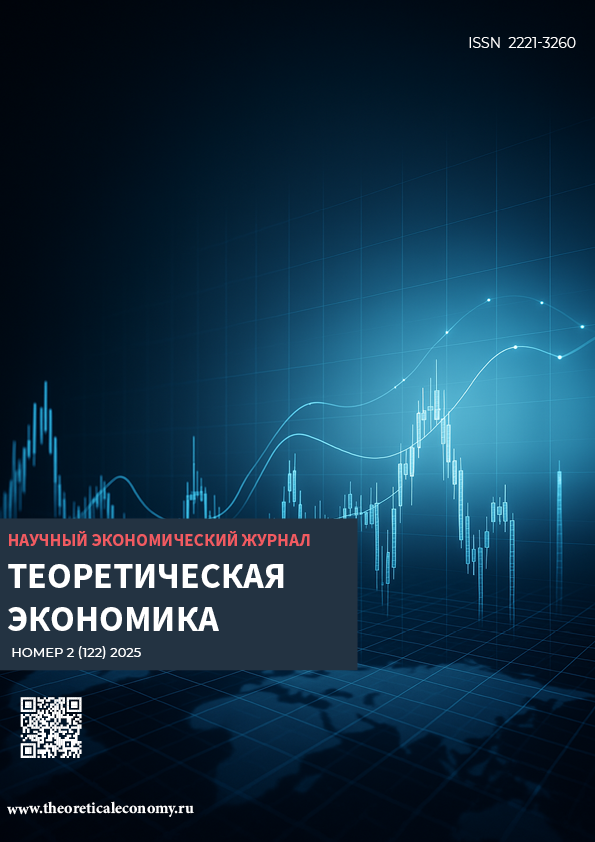Institute for Advanced Training of Executives and Specialists
Academy of Labour and Social Relations
Moscow, Moscow, Russian Federation
Samara, Samara, Russian Federation
VAK Russia 5.2
The continuous complication of economic conditions invariably entails the search for increasingly effective approaches to managing complex socio-economic systems. One of the areas of the search for approaches to solving this problem is the study of the possibilities of applying Burkhard Heim’s field theory in management, which involves the use of the principles of the quantum theory he developed in the science of managing complex socio-economic systems - enterprises and organizations. As a starting point for studying B. Heim’s quantum theory in management, which combines gravity, electromagnetism and quantum mechanics, many researchers in this area consider the issues of interaction between consciousness and physical reality in relation to solving management problems. Just as B. Heim was never able to bring his theory to its logical conclusion, subsequent researchers who have sought to transfer the provisions of B. Heim’s quantum theory to the field of management have not yet managed to build a sufficiently harmonious relationship between them. In this regard, the purpose of these studies was to search for problems and prospects for using B. Heim’s quantum theory in management. This work is based on a set of theoretical research methods, including: abstraction, analysis, analogy, generalization and formalization.The main results of the conducted research consist in explaining the nature of the functioning of enterprises and organizations as controlled socio-economic systems from the standpoint of quantum mechanics by drawing a set of analogies concerning: energy, momentum, angular momentum and other quantities of the bound state of the system under study; limitations of the system under study by discrete values; possession of both discrete and continuous characteristics by the systems under study; implementation of the uncertainty principle in the systems under study. The presented results allow us to move on to further research concerning a more detailed consideration of the quantum and wave nature of the activities of enterprises from the standpoint of management, including the superposition of the provisions of quantum and wave theory.
B. Heim’s field theory, application in management, quantum approach to organizational activity of complex systems, management decision making
1. Albert Einstein. Die Feldgleichungen der Gravitation // Sitzungsberichte der Preussischen Akademie der Wissenschaften zu Berlin. — 1915. — 25 november. — P. 844—847.
2. Bennis, Warren G.; Nanus, Burt. Leaders: the strategies for taking charge. — New York: Harper & Row, 1985. — 244 p.
3. Cantillon, Richard. An Essay on Economic Theory [1755]. — URL: https://mises.org/library/book/essay-economic-theory (data obrascheniya: 01.01.2025).
4. Clancy, L. J. Aerodynamics. — London: Pitman Publishing, 1975. — 610 p.
5. David Leong, Lau Yin Cheng, Arthur Chen. Integrating Burkhard Heim’s Unified Field Theory into Management Science: A Quantum Approach to Organisational Complexity. — URL: https://www.researchgate.net/publication/381412856_Integrating_Burkhard_Heim’s_Unified_Field_Theory_into_Management_Science_A_Quantum_Approach_to_Organisational_Complexity (data obrascheniya: 01.01.2025).
6. Dröscher, W. Follow Burkhard Heim’s Mass Formula. — URL: https://sourceforge.net/projects/heim-theory/ (data obrascheniya: 01.01.2025).
7. Fields, C. If Physics Is an Information Science, What Is an Observer? // Information. — 2012. — Vol. 3, № 1. — P. 92—123.
8. Heimsche Theorie – Heim Theory. — URL: https://heim-theory.com (data obrascheniya: 01.01.2025).
9. Hilbert, M. How to Measure «How Much Information»? Theoretical, Methodological, and Statistical Challenges for the Social Sciences // International Journal of Communication. — 2012. — Vol. 6. — P. 1042—1055.
10. Leong, D. Re-contextualizing opportunity as artifact signalling for entrepreneurial action // Journal of Developmental Entrepreneurship. — 2021. — P. 2150021.
11. Lester Haines. Scientists moot gravity-busting hyperdrive. Mars in three hours — theoretically // The Register. — URL: https://www.theregister.com/2006/01/06/hyperdrive/ (data obrascheniya: 01.01.2025).
12. Lietz, H. Take a leap into hyperspace // New Scientist. — 2006. — № 2533 (189). — URL: https://www.newscientist.com/article/mg18925331-200-take-a-leap-into-hyperspace/ (data obrascheniya: 01.01.2025).
13. Stonier, T. Information and the internal structure of the universe: An exploration into information physics. — Springer Science & Business Media, 2012. — 155 p.
14. Stonier, Tom. Information as a basic property of the universe // Biosystems. — 1996. — Vol. 38, № 2—3. — P. 135—140.
15. Taylor, Frederick Winslow. Shop Management (With an introduction by Henry R. Towne). — New York, London: Harper & Brothers, 1911. — 207 p.
16. Xinyi Yin. Review and Prospect of Quantum Management // American Journal of Industrial and Business Management. — 2019. — Vol. 9, № 12. — P. 2220—2230.
17. Zeilinger, A. Dance of the Photons: From Einstein to Quantum Teleportation. — New York: Farrar, Straus and Giroux, 2010. — 305 p.
18. Zohar, D. What Is Quantum Management? // Zero Distance. — Singapore: Palgrave Macmillan, 2022. — URL: https://doi.org/10.1007/978-981-16-7849-3_4 (data obrascheniya: 01.01.2025).
19. Zurek, W. H. Quantum Darwinism // Nature Physics. — 2009. — Vol. 5, № 3. — P. 181—188. DOI: https://doi.org/10.1038/nphys1202; EDN: https://elibrary.ru/XXDJSU
20. Al'beverio S., Gestezi F., Heeg-Kron R., Hol'den H. Reshaemye modeli kvantovoy mehaniki. — M.: Mir, 1991. — 568 s.
21. Belyackiy, N. P. Kvantovaya filosofiya menedzhmenta // Belaruskaya dumka. — 2022. — № 11. — S. 72—80. EDN: https://elibrary.ru/EHYBIC
22. Giperdvigatel' mezhzvezdnogo korablya. — URL: https://scorcher.ru/journal/art/art35.php (data obrascheniya: 01.01.2025).
23. Kaku, M. Vvedenie v teoriyu superstrun / per. s angl. G. E. Arutyunova, A. D. Popova, S. V. Chudova; pod red. I. Ya. Aref'evoy. — M.: Mir, 1999. — 624 s.
24. Mah, E. Vvedenie k ucheniyu o zvukovyh oschuscheniyah Gel'mgol'ca / per. s nem. E. Sysoevoy. — Sankt-Peterburg: tip. R. Golike, 1879. — 87 s.
25. Tebekin, A. V., Kasaev, B. S. Menedzhment organizacii. — 4-e izd., pererab. i dop. — Moskva: KnoRus, 2015. — 420 s.
 This work is licensed under Creative Commons Attribution-NonCommercial-NoDerivatives 4.0 International
This work is licensed under Creative Commons Attribution-NonCommercial-NoDerivatives 4.0 International


















